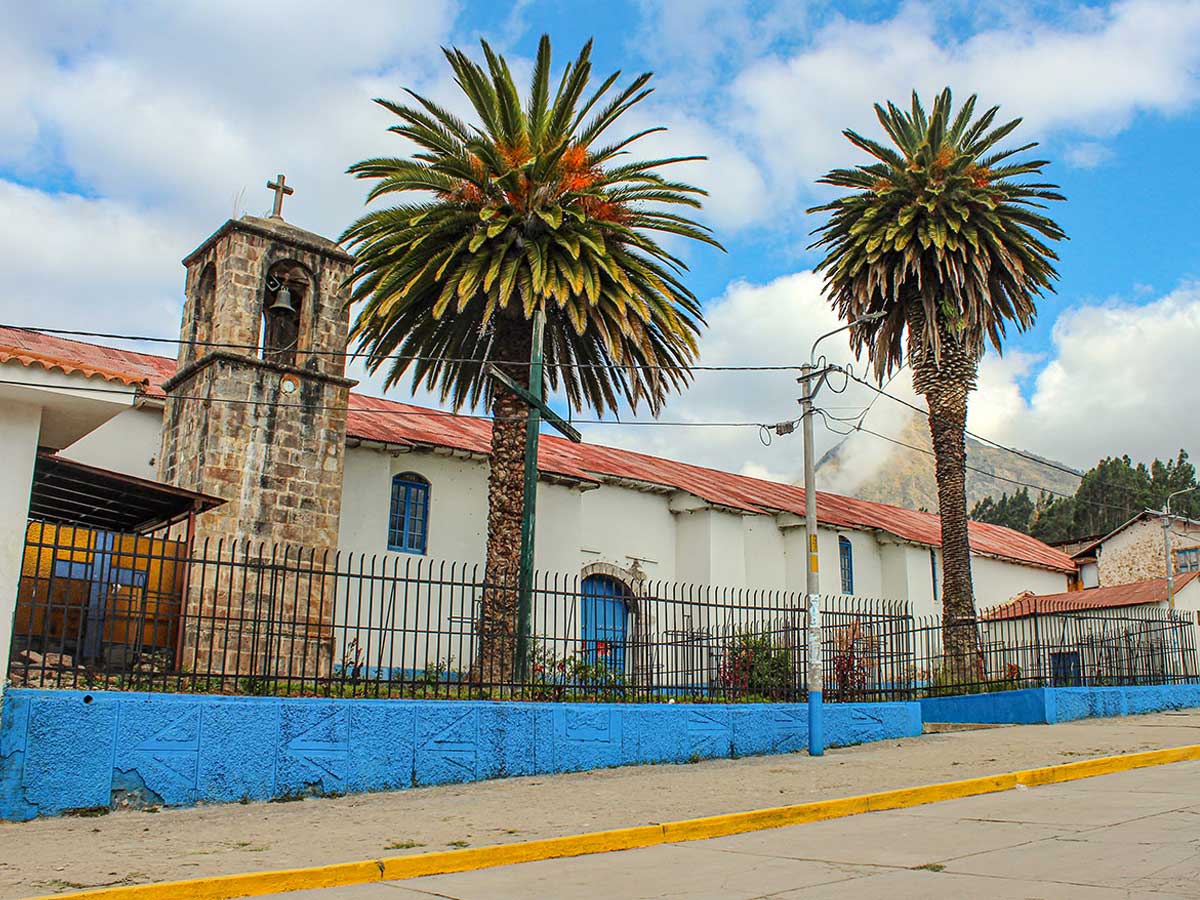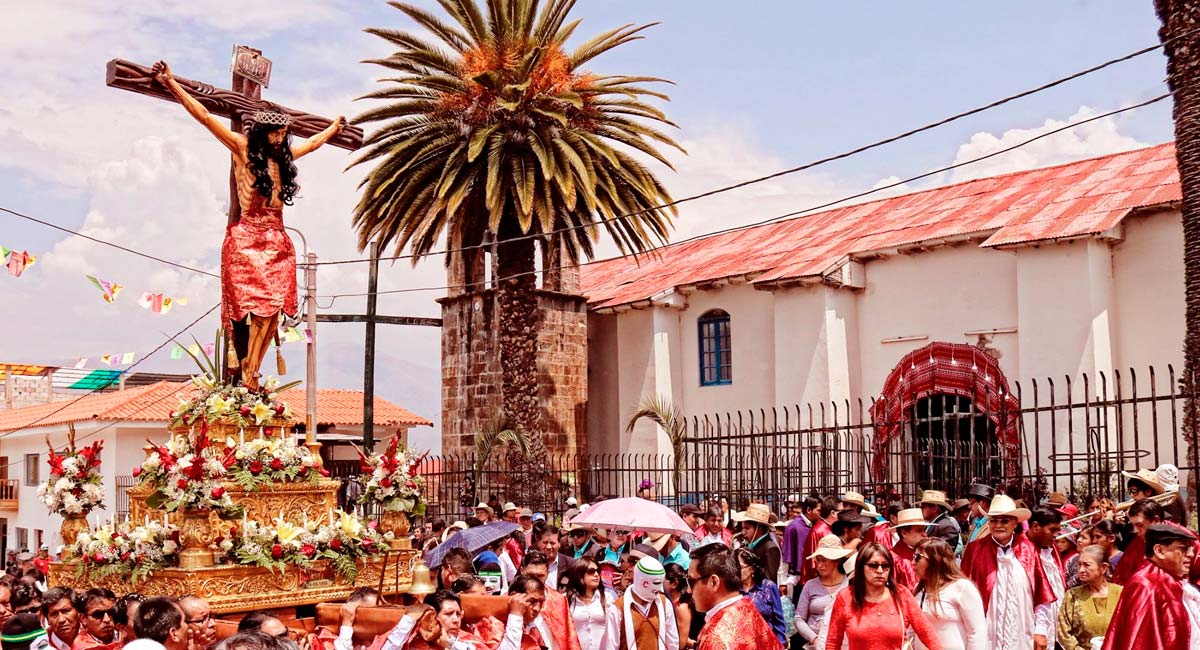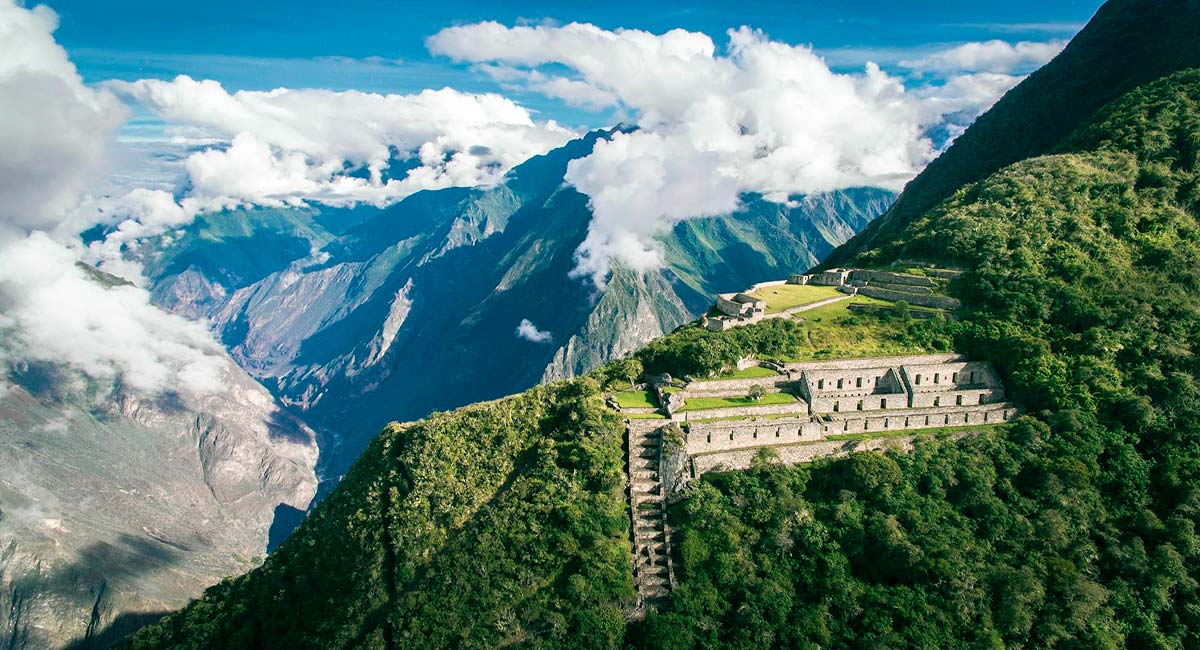
The Peruvian District of Mollepata in Cusco Perú is one of the 9 districts of the Anta Province, located in the Department of Cusco, under the administration of the Cuzco regional government.
90 kilometers from the City of Cusco and one hour from Yucay is Mollepata in Cusco Perú, one of the districts of the Anta province. Before arriving at this destination, the towns of Anta, Ancahuasi and Limatambo are toured, territory where the Incas had to fight against the fierce Chancas who were fighting for the supreme power but who, finally, were defeated at the hands of who would forge the fate of the Empire. Inca: Pachacuteq.
Mollepata in Cusco Perú is a decent sized Peruvian mountain town. A few hours by car from Cusco, it is the starting point for backpackers who take the path to Salkantay Mountain.
Mollepata area: 35,600 hectares / 356.00 km²
Geographical coordinates: 13°30′33″S 72°31′40″O
|
|

The main economic activity of the Mollepata district is: agriculture, livestock and tourism. Due to the variety of the climate, it has products that correspond to the three climates such as sugar cane, a wide variety of cereals, fruit trees, legumes and vegetables.
Mollepata is a town of Inca origin, with a notable presence of monumental archaeological remains, as well as agricultural terraces and ancient paths distributed in various sectors. According to numerous historians, during the Inca period, Mollepata was well organized and had a system of administration and control for the settlers who worked in different ecological zones, such as the puna and the yunga.
With the Spanish invasion and during the colonial period (16th, 17th, and 18th centuries), profound social changes occurred in Mollepata. At the head of the new social structure were the Spanish and their descendants, who became landowners. Meanwhile, the indigenous people remained marginalized and trapped in conditions of poverty, constantly fighting to improve their situation.
Subsequently, after independence, forms of exploitation similar to feudalism persisted. Peasants were forced to work on haciendas in exchange for accommodation, a situation that continued until the promulgation of the Agrarian Reform Law between 1968 and 1970.
The Marcahuasi hacienda, owned by David Samanez Ocampo, played a prominent role in the local and departmental economy. Located south of the town of Mollepata, next to the old passable road, this hacienda housed extensive sugarcane plantations. Thanks to this, infrastructure for large-scale aguardiente production was installed, including large sugar mills and a modern distillery plant.
In addition, sugar and chancaca were manufactured in industrial quantities at Marcahuasi. Crops such as orange and lemon were introduced, with very favorable results. In the livestock sector, improved breeds were incorporated, significantly boosting quality livestock farming in the area.
As in many places in Peru, Mollepata experienced a period of intense social upheaval during the Agrarian Reform promoted by the government of General Juan Velasco Alvarado. Communards and peasants occupied the local haciendas and formed cooperatives that, over time, could not sustain themselves and had to parcel out the lands of the old haciendas.
Since the colonial era, Mollepata Peru was a territory subordinate to the district of Limatambo, a situation that caused discomfort among its inhabitants, who longed for autonomy and freedom to make their own decisions. After intense management that lasted 10 years, 5 months, and 12 days, Law N° 6623 was promulgated on April 29, 1929, by which Mollepata was elevated to the category of district in the province of Anta.
Currently, the district of Mollepata comprises the following partialities: Abuela, Accobamba, Ayrancca, Huayrurani, Ccotomarca, Mallau, Bellavista, Tantay, Antabamba, Huamanpata, Auquiorcco, La Estrella, Marcahuasi, Huaychi, Tillca, Parobamba, Marcahuaylla, Cisal and Soray.
Mr. Manuel de la Exaltation of the Holy Cross
One of the most important and representative celebrations in the district of Mollepata is the festivity of the Señor Manuel de la Exaltación de la Santa Cruz, which stands out for its deep religious character. This event brings together the entire community, which from September 13 dresses in their best clothes to pay homage to their patron saint. The central figure of this festivity is a wooden sculpture, approximately 1.20 meters high, known as the Señor de la Exaltación. This image is considered miraculous and is deeply venerated by the locals.

Feast of the Holy Cross of Tillca
Another important celebration in Mollepata is the worship of the Santa Cruz de Tillca, which takes place annually on May 2, 3, and 4. During this festivity, the inhabitants make a pilgrimage to the top of Cerro Tillca, in an act of faith and devotion that strengthens spiritual and community ties.
Popular Activities
As part of the traditional festivities in Mollepata, various activities are also carried out that combine religiosity and popular customs:
Bullfighting and colt breaking, which bring together a large part of the community and visitors.
Cockfights and cock pulling, cultural expressions with strong local roots.
The Mollepata district is located in the Anta province, in the Cusco region. The tourist promotion of this district is not yet very high, however, visits to it have been increasing as a result of trekking routes enabled in the region.
Mollepata is a tourist destination that travelers can choose, especially if they have an interest in rural tourism, long walks, and sightings of beautiful natural settings, but also if they want to discover some of the remains that pre-Hispanic cultures left for immortalize. Mollepata is the starting point of the Salkantay Trek.
The archaeological resource that the traveler can find on his visit to Mollepata, is known by the name of Choquequirao. Choquequirao would have been during the Inca period, an important citadel and fortress, which stood out for having been the last point of resistance of the Incas that populated Vilcabamba.
Regarding adventure tourism, the Mollepata district has been positioned, in recent years, as the starting point of different trekking routes that lead to Salkantay Trek and Machu Picchu. The Salkantay Trek from Mollepata can take between 4 and 11 days and allow you to get to know different tourist resources in the Cusco region.
If you want to know this beautiful and peaceful district, especially during its main celebrations, the traveler is recommended to go to it on dates such as September 14, when the town pays homage to the Lord of Exaltation in the midst of both liturgical events as traditional. The main tourist attractions in Mollepata Cusco are:
The name Choquechurco probably comes from the words Aymara CHOQUE, which means Gold and CHURCO, which in Quechua term means to place, locate, pigeonhole, deposit, guide, use, locate, etc. Consequently Etymologically speaking CHOQUECHURCO was the place "where the gold was placed".
It is located in the buffer zone of the archaeological site of Machu Picchu, in the sector called Markahuaylla, in the upper part known as Huancanapata about 10 km, from the town of Mollepata at 3,200 masl. in a space covered by totally intricate vegetation that has been affected by the finely carved walls and walls over time.
Choquechurco has two embankments, which were possibly places for ceremonial acts; A few meters away, Inca walls can be seen almost buckling under the pressure of the native trees.
Its development would have been registered in the late horizon, during the governments of the Inca Pachacuteq, Tupac Yupanqui or Huayna Capac. It is characterized by the style of polished stone, well assembled dry and solid in nature. In shockechurco the details are finely carved limestone, polygonal walls, trapezoidal walls that exceed a meter with 80 cm, the most surprising thing about this enclosure is the presence of a limestone rock of a dimension of about 5 meters in diameter where a frame of 2 meters with 20 cm width and 2 meters with 40 cm height, with some cornices to possibly hold gold and silver plates directed to the Sun God salient, it could be an agricultural calendar or place where signs and provisions were imparted that today they are a mystery.
From that place, the entire landscape of the snow-capped mountains can be viewed with complete amplitude: Ampay, Socllaccassa, Salkantay, Umantay, Limatambo Valley, Sauceda, Abra de Huillki, Pampaconga, Pivil, Chonta and Cotabambas in Apurimac. For these characteristics it was probably one of dominion, position, administration during the Inca empire.
The church of Mollepata is modern, built perhaps on an Inca huaca, as was the custom of the Spanish, to replace a native place of worship with a Catholic one. It is located on the western side of the main town square; There, the most venerated image is Señor Manuel de Exaltación de la Santa Cruz, a beautiful sculpture carved in wood.
It is the name of a pointed hill with a conical shape, it is located four kilometers west of the town of Mollepata, it was a signal station, an observation point for the surrounding territories, and an astronomical observatory, therefore it was a sacred place, that is huaca. At the top there is a cross and very few traces on the surface, with respect to the incan. On the flank of the hill there are five old platforms, and towards the Choquechurco side, four, all in poor condition.
It is a town, it was very important and a great Inca seat, today it offers several archaeological groups, beautiful Inca walls. What stands out the most is the following:
A beautiful old wall with twelve niches, on which a shed has been built that serves as housing for some peasants, it seems to us that it is the internal face, a back wall, which today deprived of the other walls, remains with the face towards the open field. The building must have been one of the best, perhaps if it was an Inca palace.
The terraces make up a set, they are on the eastern side of Marcahuasi, they have all the virtues of other identical sets built by the Incas, say arrangement, location, height of the walls, good land on the embankments and aqueducts.
The Qoriwayrachina or Corihuayrachina hill is part of Marcahuasi, it is towards the side of the main valley, it is an amazing archaeological repository, with fractional ceramic on the surface (ancient sherds), ruined low walls.
At all times Marcahuasi was an important agricultural center, due to the fertility of its lands and its good climate. Garcilaso de la Vega says that on January 21, 1560, while traveling from Cusco to Lima, and then continuing to Spain, he passed through an estate called “Marcahuaci” nine leagues from Cusco, owned by Pedro López de Cazalla, a native of Llerena. and a neighbor of Cusco, there he found the estate "loaded with beautiful grapes". There it was made for the first grape wine, in what corresponds to the Cusco region.
Choquequirao (from Aymara chuqi, gold, and from Quechua k’iraw, cradle, that is to say: “cradle of gold”), is an Inca city located between the foothills of the snowy Salcantay, in southern Peru. The Choquequirao archaeological remains are made up of buildings and terraces distributed on different levels, from the lowest Sunch'u Pata level to the highest truncated summit, which was leveled and fenced with stones to form a platform with an approximate area of 150 square meter.
Choquequirao (sometimes also referred to as Choqequirau or Choquekiraw) is known as the "sacred sister" of Machu Picchu for its structural and architectural resemblance to it. Recently, being partially excavated, it has sparked the interest of the Peruvian government to further recover the complex and make it a more accessible alternative for tourists interested in learning more about Inca culture.
Mollepata was one of the entrance doors to the Vilcabamba región, the administrative, political, social and economic nucleus of the Inca Trail. Thus, with regard to its urban conception, the symbolic patterns of the imperial capital itself were followed, that is, the places of worship of the Sun, the earth, the ancestors, the water and other divinities. In addition, there were also royal residences, houses of administrators and artisans, large dormitory buildings also called kallancas, agricultural platforms of the Inca and the town, and warehouses. In this Mollepata Inca Trail, we find a ceremonial area that has about 700 meters, with a gap between the main square and the highest parts of up to 65 meters.
It was from this building that the Incas of the Manco dynasty were able to resist the Spanish invasion for about 36 years, in fact, it was never possible to expel them from this city that only recently has gained its identity from the tangled jungles of Peru.
To get to this Mollepata Inca Trail you must follow the Salkantay Trek.

It is a farm located to the southwest, below and very close to the town of Mollepata; Going up by car along the road that leads to Mollepata, La Estrella is on the left side and in the last sections of the road. The estate has a house-hacienda with an unbeatable location, like a pulpit hanging over the area, it is an exceptional viewpoint; the building is a beautiful architectural complex, with gardens, orchards, all expresses elegance and lordship, it was the residence of don David Samanez Ocampo.
Soraypampa is to the north of Mollepata, at 3950 masl. During the Inca period it was a ceremonial space for the Huaca Salkantay. Today the snow-capped mountains of Umantay and Salkantay are observed in the landscape environment of Soraypampa in Mollepata. Due to the location of Soraypampa in Mollepata, it is an appropriate camping area, used by groups of tourists who make the route to Santa Teresa, Choquequirao and Machu Picchu.
Another must-see is the Quillarumiyoc archaeological complex, located 20 minutes from Mollepata and whose meaning, of popular origin, is founded on the figure carved in a rock of approximately seven meters: "The stone of the moon" or " The moon carved in the stone”. When you arrive at the complex, the first thing you notice is body agitation: Quillarumiyoc is at 3,400 meters above sea level. Still, the tour of the place is impressive.
Although there is still little historical evidence of the origin of this complex, it is known that Quillarumiyoc was a very important religious ceremonial center in the Pampa de Anta, on the way to Chinchaysuyo, where Andean priests worshiped their gods, according to observation, to the study and analysis of the stars. "This is part of the tourist circuit and the area itself has a mystical interpretation because it has a set of carved rocks, caves, ceremonial places like the Usno, a circular platform that served to see the movement of the stars", says Patrick Hermoza, local tourist guide, whose agency has developed a mystical tourism circuit given the ceremonial importance of Quillarumiyoc.
The complex also includes cultivation and irrigation system areas, which makes this archaeological zone a technological, artistic and religious manifestation of ancestral cultures that expressed their worldview in every aspect of their existence.
From Cusco to Mollepata it is 88 kilometers by bus. In this detour, you leave the main road and ascend for 10.5 kilometers along a route in good condition. From Cusco to Mollepata by bus takes an hour and 45 minutes approximately.
To get from Cusco to Mollepata by bus there are at least four options:
Take a bus to Curahuasi (large and comfortable bus) at the Cuzco land terminal, located on Av. Vía de Evitamiento No. 429. Get off in Limatambo and take a bus to Mollepata. It will be necessary to pay the entire passage to Curahuasi.
Take a combi to Limatambo, and from there take a bus to Mollepata. These combis are taken at the Arcopata street terminal, shortly before the corner with Apurimac Avenue. Contract a private service from Cuzco, in the order of 90 soles
Coordinate only transport with any of the many tourism companies that take tourists in a guided way to Salkantay. Between the end of May and September, several companies leave every day, so it is possible to request an available space and arrange a price. Of course, this option is only plausible if it is a small group.
If you arrive early at the Plaza de Mollepata (before 9:30 or 10 AM), it is highly likely that you can coordinate transportation from Mollepata to Soraypampa with some of the tourist companies that carry clients. In particular, small trucks carry food and equipment, so the drivers themselves offer a space next to the load to get extra money. The author of this review was charged ten soles for this service. If you want to travel more comfortably from Mollepata to Soraypampa, you can also try to coordinate transport with the minivans that take tourists, but a) it will cost more, and b) it is more difficult for space to be available.
Consider a little over an hour by truck to Soraypampa. Minivans don't take much less.
Salkantay Trek Machu have the authorization to operating on the Inca Trail, Salkantay Trek and all alternative treks to Machu Picchu.
Salkantay Trek Machu is a one of the premier tour operators in Peru. It is specialises in small groups, family holidays, luxury travel, adventure trekking and tailor made travel to suit your personal requirements